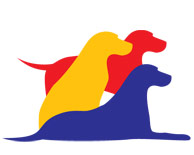I often wish I had the ability to draw. I would draw cartoons of dogs and their people. My very first cartoon would be of a dog and his owner walking. The dog would be pulling on the leash, leaning forward, panting hard. The owner would be leaning back, pulling hard, huffing and puffing. The next frame would be of the owner, draped on a chair, still huffing, puffing and sweating. The owner would be complaining to his friend. “My dog pulls so hard on the leash, you would not believe! It takes all my strength to hang on to him!” The last frame is of the dog, complaining to his dog friend. “My owner walks so slow. You would not believe how hard I must pull just to get him around the block. I’m exhausted!”
Teaching a dog to walk nicely on a leash is one of the most difficult tasks facing a dog owner. Most tasks we “teach” our dogs are things the dog already does, we just teach him to do the task when we ask. For example “sit” or “down”: the dog already knows how to sit or lie down. We are just teaching the dog when we want him to sit or lie down. Walking on a leash is an entirely new thing to a dog – a completely foreign concept. Think of the difference between learning French and Chinese. French uses the same alphabet and many of the same concepts as English. Chinese, on the other hand, is a whole new alphabet, entirely new concept of language. In a similar fashion, dogs are completely mystified by our desires to have them walk slowly, near us, ignoring everything the dog finds interesting. To teach the dog to walk on a leash, we must go slowly, making sure the dog understands what is required.
First, we teach the dog to notice us when we are outside. Yes, I know, you are the sun and the moon to your dog – until you go outside! Once outside, many dogs simply will not even look in the direction of their owner. To teach your dog to look at you, see Texas Dogs and Cats July 2010 issue (available on the web site) for instructions. Practice having your dog look at you in every room in your house, then in the back yard, then on the front stoop, then in the front yard.
As we begin actually walking the dog on a leash, remember that the leash is ONLY to keep the dog from running away. Do not use the leash to make your dog stay with you. Use your voice and treats to put your dog in the correct position. When beginning to teach a dog to walk on a leash, it is best to choose one side of you for the dog. If you plan on competing in a dog sport, you must choose the left, otherwise it does not matter. Lure your dog to the side you have chosen using a high value treat such as chicken, turkey or beef. Do not worry if the dog is facing the wrong direction, I have yet to see a dog walking around backwards! Take ONE step forward, and offer your dog a treat next to the seam on your pants. While teaching leash walking, we will always offer a treat right next to the seam of your pants. Take one step forward, then offer the dog another treat. Remember, when your dog gets out of position, lure him back to your side with a treat. Do not use the leash to drag the dog into the desired place.
When your dog begins to stay by your side, take two steps, then offer a treat by the seam of your pants. Repeat, repeat, repeat! Occasionally, take three steps. Go slowly! If you increase the number of steps too quickly, your dog will not understand. If you take your dog from kindergarten (one treat per step) to college (around the block with one or two treats) he will not succeed! Go from kindergarten (one treat per step) to first grade (one treat for every two steps) to second grade . . . ok, you get the idea. Go slow, and you will be rewarded with a dog that understand what you require him to do.
Next month, we will look at pitfalls of leash walking.
Happy Training!
Tricia Fagan
Certified Professional Dog Trainer – Knowledge Assessed
DogS Gone Good
trainer @ dogSgonegood.com (remove spaces to send email)
(713) 557-1949



